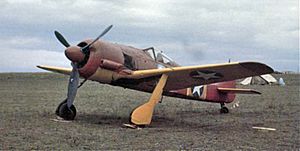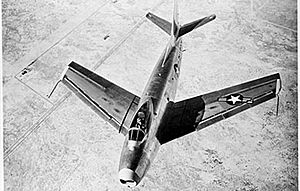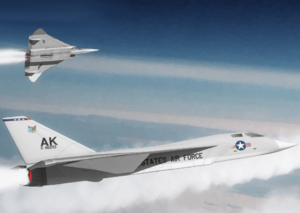Kenneth O. Chilstrom facts for kids
Quick facts for kids
Kenneth Oscar Chilstrom
|
|
|---|---|

Chilstrom in 1961
|
|
| Nickname(s) | K.O. |
| Born | April 20, 1921 Zumbrota, Minnesota, U.S. |
| Died | December 3, 2022 (aged 101) Fort Belvoir, Virginia, U.S. |
| Allegiance | United States of America |
| Service/ |
|
| Years of service | 1939–1964 (25 years) |
| Rank | |
| Commands held | Chief of Fighter Test, 1946–48 USAF Test Pilot School, 1949–50 F-108 Program Manager, 1958–59 |
| Battles/wars | World War II Cold War |
| Awards | Distinguished Flying Cross Air Medal |
| Other work | Aerospace Industry Author |
Kenneth Oscar Chilstrom (born April 20, 1921 – died December 3, 2022) was an amazing pilot and officer in the United States Air Force. He was a combat veteran, a test pilot, and even an author. Ken was the very first Air Force pilot to fly the XP-86 Sabre jet. He also led the fighter test team at Wright Field and was in charge of the U.S. Air Force Test Pilot School. Ken also flew in the first ever jet air race and delivered the first air mail using a jet plane! During World War II, he flew more than 80 combat missions in Italy. He even tested over 20 different German and Japanese planes to learn their secrets.
| Top - 0-9 A B C D E F G H I J K L M N O P Q R S T U V W X Y Z |
Early Life and Dream of Flying
Ken Chilstrom was born on April 20, 1921, in Zumbrota, Minnesota. This was a small town in the southeastern part of Minnesota. From a young age, Ken loved airplanes. He started building model airplanes when he was still in elementary school.
After finishing high school in 1939, Ken wanted to become a pilot. He went to a military office to sign up for pilot training. However, he didn't have enough college education to join the pilot program. So, Ken joined the United States Army Air Corps to train as an aircraft mechanic instead.
Military Career and Becoming a Pilot
Ken finished aircraft mechanics school at Chanute Field in Illinois. He even became an instructor there. But he still really wanted to fly! He took night classes to get the college credits he needed.
Soon, the Army Air Corps needed more pilots. Ken was accepted into the pilot training program. In October 1942, he officially became a pilot and an officer. He graduated with his class in Louisiana. Ken was then sent to Bolling Field to help guard Washington, D.C.
Flying in World War II
In February 1943, Ken's group received new P-40 Warhawk planes. They took these planes to North Africa on a ship called the USS Ranger. Ken and his fellow pilots arrived in Africa after a tough battle.
His group had to give their P-40s to another unit that had lost their planes. Ken then joined the 27th Fighter Bomber Group. He flew 80 missions in the North American A-36 plane over Sicily and Italy. In November 1943, his combat tour ended, and he returned to the United States.
Becoming a Test Pilot
Ken really wanted to work in flight testing at Wright Field in Ohio. This was a dream job for many fighter pilots. At first, there were no test pilot jobs open. But Ken managed to get a job as a maintenance officer for the Chief of Fighter Test.
Flight testing at Wright Field grew quickly. This gave Ken the chance to achieve his dream. He tested many different P-47 Thunderbolt planes. This included the XP-47J, which was one of the fastest piston-engine fighters ever built.
During his seven years as a test pilot, Ken flew 147 different aircraft! These included special "X" and "Y" models, plus planes from the United States, Germany, and Japan. Many German and Japanese planes captured during World War II were sent to Wright Field. Ken got to fly and evaluate over 20 different models.
These planes included the Focke-Wulf Fw 190, the Messerschmitt Me 262 jet, the A6M Zero, and the Kawasaki Ki-45 Nick. He flew the Fw 190 a lot. Once, on February 24, 1945, a problem with the plane's trim switch almost caused a crash. Ken was landing when the nose suddenly pitched up. He managed to regain control and safely land the plane. Other pilots were not as lucky with this plane's electrical problems.
Ken also flew the United States' first twin jet engined fighter aircraft, the Bell P-59 Airacomet. In February 1945, he was delivering a P-59 when an engine failed during takeoff. He crashed into some trees. The plane was destroyed, but Ken survived with only minor injuries. This was one of the first big jet accidents for the U.S. military.
Ken graduated in the first group of the Flight Performance School. This school is now known as the United States Air Force Test Pilot School. His friend Glen Edwards was his roommate. Edwards Air Force Base is named after Glen.
In September 1946, Ken became the chief of the Fighter Test section. He was in charge of a very special group of pilots. These included famous names like Bob Hoover and Chuck Yeager. In 1947, Ken was recommended to fly the Bell X-1 to break the sound barrier. However, his commander wanted him to work on the XP-86 Sabre project instead. Ken was the first Air Force officer to test the XP-86. By December 1947, he had tested the plane at high altitudes and speeds.
Between 1949 and 1950, Ken was the leader of the USAF Test Pilot School. He led the last classes held at Wright Field. After that, the school moved to Edwards Air Force Base in California. In 1949, he was also a technical advisor for the movie Chain Lightning starring Humphrey Bogart. In 1950, Ken was chosen to be part of a pilot exchange program with the United Kingdom's Royal Air Force. He flew 25 different British planes in just two months!
Working on Aircraft Development
In 1950, Ken left flight testing to work on fighter requirements. He worked at Air Force Headquarters on planes like the F-100 Super Sabre and the F-105 Thunderchief. In 1958, Ken was promoted to Colonel. He returned to Wright Field as the program manager for the F-108 Rapier. This was a fast, long-range interceptor aircraft.
The F-108 project was canceled in 1959. Ken then supported the Lockheed YF-12 program. His last job was at Andrews Air Force Base. He retired from the Air Force in January 1964 after 25 years of service. After retiring, he worked in the aircraft industry for companies like General Electric and Boeing-Vertol.
Amazing Aviation Firsts
Besides being the first Air Force pilot to test the XP-86, Ken Chilstrom was part of many other aviation "firsts."
First Jet Air Mail Delivery
To show what the Army Air Corps could do, Ken and another pilot, Captain Robert Baird, delivered the first air mail by jet aircraft. This happened on June 22, 1946. They carried mail, including a letter for Orville Wright. Ken flew a P-80 Shooting Star jet from New York to Dayton, Ohio. After stopping at Wright Field, he flew on to Chicago, Illinois, to finish the delivery.
First Jet Air Race
Ken also took part in the first "closed course" jet air race. This was at the 1946 Cleveland National Air Races in Ohio. Three P-80 Shooting Stars from Wright Field raced against three P-80s from California. Ken had to leave the race because of mechanical problems with his plane. The race was won by Major Gustav E. Lundquist.
In 1948, Ken asked to be part of the first pilot exchange program between the Air Force and the United States Navy. He trained at Naval Air Station Pensacola. He learned to fly the SNJ and made six landings on the aircraft carrier USS Wright. Ken then joined a Navy air group. He made 50 carrier landings in the F8F Bearcat plane aboard the USS Leyte.
Later Years and Legacy
In 1991, Ken Chilstrom and another pilot wrote a book. It was called Test flying at Old Wright Field. The book shared the experiences of the "Wright Stuff" pilots and engineers. A second edition came out in 1993 with more photos and stories.
Ken's wife, Ruth, passed away in May 2006 after 57 years of marriage. She is buried in Arlington National Cemetery. At that time, Ken had two sons, a daughter, and six grandchildren.
In 2016, Ken visited Wright-Patterson AFB. He attended the grand opening of a new building at the National Museum of the United States Air Force. This gallery shows flight test aircraft flown by pilots like Ken. These planes helped advance aerospace technology.
Ken Chilstrom passed away in Fort Belvoir, Virginia, on December 3, 2022. He was 101 years old.
Honors and Awards
During his time fighting in World War II, Ken Chilstrom earned the Distinguished Flying Cross. He also received the Air Medal with eight oak leaf clusters. In 2008, he was recognized in Air Force Magazine as a famous flyer of the F-86 Sabre.





